
University of Kentucky Department of Entomology







Classroom Mascotsby Stephanie Bailey, Extension Specialist and
|
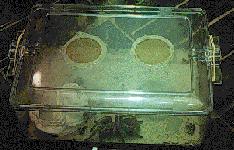 S. Bailey, 1995 | In general, the bigger the container, the better. At the very minimum, a container should be at least twice the insect's width and five times its length. Gallon jars, aquaria, and plastic food containers are very easy to find and make great bug houses. |
Be sure the container is rinsed of any soapy (or other chemical) residues, which may harm the insect. Lids should be ventilated, or use a fine, screen-like material (such as nylon stockings) placed over the top. Secure the lid, you don't want the insect to escape!
| Adult insects can get by for a few days with a little moisture (from a clean sponge or cotton-stoppered test tube filled with water). | 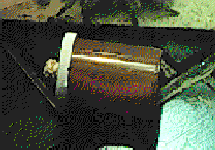 S. Bailey, 1995 |
Keep the insect by itself (so it is not eaten or doesn't eat others) and keep the container out of direct sunlight, and away from heating or cooling vents and drafts. Most insects are more comfortable with even a minimal habitat such as rocks, sticks and/or crumpled paper towel for the insect to hide in. Immature insects such as caterpillars must have food to survive. Ensure a food supply before bringing caterpillars into the classroom.
Long-term visitors have a few more needs. The container will need to be cleaned periodically (caterpillar containers should be changed every few days at least). Research the insect's natural environment, and try to make its container hospitable. Always have a source of moisture available. Make sure you will be able to provide plenty of food for the insect. Is it a predator or a leaf feeder? Where can you get food? If you can't determine what the insect eats, don't plan to keep it for more than a few days. Check to be sure there is enough food and water to tide the insect over on weekends. During long holidays it may be best to either take the insect home or set it free, as weather permits.
Partial list of insects for long-term observation
PREDATORS
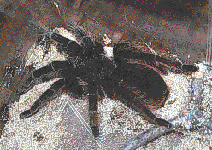 S. Bailey, 1995 | Tarantulas are not native to Kentucky but are available from some pet stores. Many species of spiders are native to Kentucky. All spiders have venom in their fangs, but the only two spiders that are generally considered dangerous in Kentucky are the brown recluse and the black widow, which both have very distinctive markings. |
Spiders and tarantulas need a live food source, such as houseflies, small caterpillars, mealworms or crickets (available from bait shops). They may not eat very often, but always have something available to them. Line the bottom of the container with sand, and include sticks and rocks or cardboard tubes so the animal has places to hide. A moistened sponge or test tube with water, stoppered with cotton will provide enough moisture.
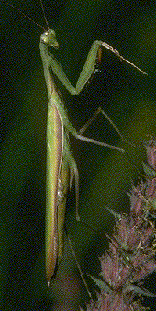 Corel PhotoCD | Praying mantids can be found in the fall, and are easily fed with a supply of crickets, which can be purchased from a bait shop. Mantids need a large jar, with a large stick-- they often hang upside-down. Have water available. Make sure the lid is secure-these are fairly strong and clever. |
If a female lays an egg mass, keep the mass in a cool place (i.e. an unheated garage) over the winter so that the developing nymphs do not emerge until spring. When they do emerge they will be very hungry, and it's hard to find that many sources of food! In the spring, when they emerge, set them free (except maybe a few for observation) in a garden.
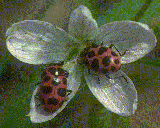 Corel PhotoCD | Ladybird beetles ("ladybugs") can be collected in the fall as they prepare to hibernate or in the spring when they are emerging. |
A new species, Harmonia axyridis, tends to overwinter in garages, barns and homes, and becomes active on sunny days, so they can be collected in the winter. Ladybugs feed on aphids and other small soft-bodied insects. Local greenhouses or garden shops may be willing to provide pest insects or insect-infested plants, or try feeding them very small mealworm larvae, from bait shops.
LEAF-FEEDERS
Caterpillars must have a lot of host plant material to complete their development. Identify the plant it is feeding on before collecting the caterpillar. Bring a fair amount of the plant material into the classroom with the caterpillar. Place a stem in a cotton-stoppered test tube with water, and if possible wind a small piece of plastic wrap or parafilm around the top of the vial to decrease evaporation. Store extra plant material in the refrigerator. Meanwhile, identify the caterpillar, and research and look for other sources of food. Change food often enough for it to stay fresh, every day to few days. Clean out the container often, since most caterpillars are rather messy. Place a stick in the container of large caterpillars, some need a vertical surface to pupate or make a cocoon with. Once the caterpillar pupates, transfer it to a tall container such as a gallon jug. Leave a stick in the jar so the butterfly or moth can climb up and spread its wings when it emerges. The jar's lid should have some ventillation holes. If found in the fall, set the jar in a cool place such as an unheated basement or garage, since some pupae need to reach a cold temperature as a signal to complete their development. In the spring, keep the jar handy and watch for changes in the pupa. A newly emerged butterfly or moth is extremely delicate, and should not be touched or bothered for several hours, until the wings are dry. Allow students to observe and take notes, and then set it free.
Milkweed bugs have reddish-orange and black markings and are found on milkweed plants in the summer and fall. While available, they can be fed pieces of milkweed leaves. During the winter, they can be maintained on unsalted sunflower seeds. Have water available, and change the food and lining often, as these insects can be messy.
| Insect galls are a plant's response to damage from certain insects. |  Univ. of KY Entomol. Dept. |
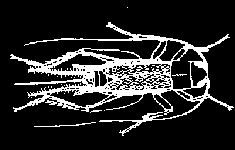 Univ. of KY Entomol. Dept. | A good initial source of crickets for a colony is from a bait shop. |
The colony's container should be dry on the bottom, have a thick layer of mulch, sawdust or sand for egg-laying, and have paper towel or toilet paper rolls for the crickets to hide in. Although they are leaf-feeders, crickets will eat dog food, crackers or bread, and must have water in a cotton-stoppered test tube. For more information, refer to Entfact 007: Rearing Crickets.
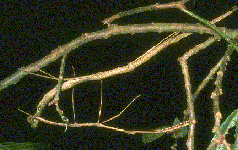 Corel PhotoCD | Walking sticks need to be housed in a taller aquarium or gallon jar because they need gravity to help them pull off the old skin when they molt. |
Line the bottom of the container with mulch, and feed them blackberry branches or deciduous hardwood (maple, redbud, sycamore, etc.) leaves.
SCAVENGERS
Ants are available through either pet stores or scientific supply catalogs. Usually, when an ant farm is purchased, it contains a coupon to send away for a colony. However, those colonies normally do not contain queens. Another option is to excavate a native ant colony. Ants are very common in both urban and rural areas, near streams and in wooded areas, under rotting logs, boards, or under mounds. Dig the colony up with a shovel, place the ants and surrounding material in a large plastic container or bag until you get back to the classroom, where they can be placed into the frame. Let the ants get settled for a few days. Feed them peanut butter, jelly, yogurt, maple syrup, or dead insects.
Hissing cockroaches and Madeiras roaches are among the larger species of roaches that can be bought from supply stores or specialized pet stores.
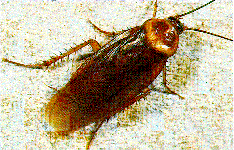 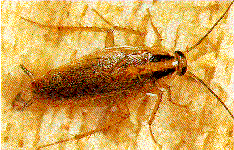 Corel PhotoCD | Other cockroaches, such as the wood roach, American roach, German roach and oriental roach are common in structures. Check in the school locker rooms and basement. If a source of structure-infesting roaches is unknown, a pest control company may be able to supply a few. |
Roaches are fairly easy to maintain--they feed on dog food. Line the bottom of the container with mulch or pieces of toweling, and place a test tube of water stopped with cotton, as well as either paper towel rolls or toilet paper rolls in the container for the roaches to hide and aggregate in. Be absolutely sure the lid is secure! You do not want to alienate the custodial staff...
| Bess beetles are larger beetles that can be collected where they hibernate, in masses under rotting logs in the wintertime. | 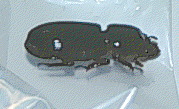 |
Mealworms can be obtained from bait shops, or found in feed or grain in barns or feed rooms. They are also very easy to take care of. Place them in a container and fill halfway with cornmeal and field corn kernels or bran. Moisture from raw potatoes, banana peels or apples will suffice. Change the meal occasionally to prevent mold and foul smells. For more information, see Entfact 002: Raising Mealworms and Fishing Worms.
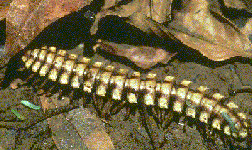 Corel PhotoCD | Giant millipedes are available from supply houses. There are some fairly large millipedes (3 inches or so) native to woodlands in Kentucky. |
Millipedes need a lot of moisture, and hardwood mulch as well as sticks to chew on. They also appreciate other decomposing matter such as chunks of apple, leaves, and dead insects.
AQUATICS
Crayfish are predacious crustaceans (insect relatives), and normally need a steady supply of food. They will eat guppies, goldfish, or aquatic insects. They don't get along very well with smaller fish. Aquatic insects can be collected with a net or even a kitchen collander. The tank will need to be aerated. Several insects such as whirlygig beetles and water striders live at the water surface.
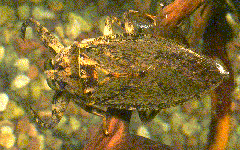 Corel PhotoCD | Insects that live underwater include mosquito larvae, dragonfly, mayfly and damselfly naiads, diving beetle adults and larvae, backswimmers, water boatmen, rattailed maggots, giant water bugs and dobsonfly larvae (helgrammites), just to name a few! |
Most of these are predators, so keep in mind the tank will probably be a good test of survival of the fittest, and will need replenishing from time to time. If you are trying to rear one aquatic insect, such as a dragonfly naiad, keep it separate and make sure it gets enough to eat--feed it mealworm larvae, small caterpillars, baby guppies, etc. as necessary. When a dragonfly naiad nears completion of its immature stage, place a large stick in the tank, so it can crawl out to molt to an adult.
Also visit
NetVet - Invertebrate Home Page
"Computer bug" cartoon courtesy of C. Ware, copyright 1997
Original document: 7 July 1995
Last updated: 2 March 1999
 Return to UK Department of Entomology Katerpillars page
Return to UK Department of Entomology Katerpillars page Return to UK Department of Entomology homepage
Return to UK Department of Entomology homepage Return to University of Kentucky homepage
Return to University of Kentucky homepage